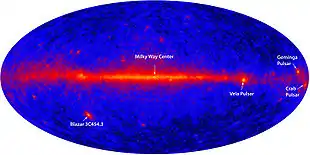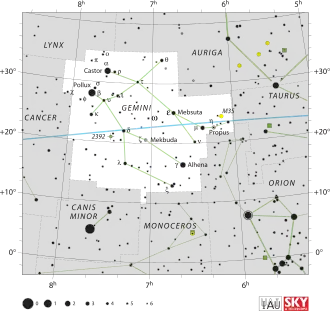Geminga
Geminga ist ein Pulsar im Sternbild Zwillinge (lateinisch Gemini). Die Entfernung beträgt etwa 800 Lichtjahre[2], ist jedoch mit großer Ungenauigkeit behaftet. Geminga und der etwa gleich weit entfernte Vela-Pulsar sind die erdnächsten bekannten Pulsare.
| Pulsar Geminga | ||||||||||||||||
|---|---|---|---|---|---|---|---|---|---|---|---|---|---|---|---|---|
 | ||||||||||||||||
| Position von Geminga in der Milchstraße (NASA/DOE/International LAT Team) | ||||||||||||||||
 | ||||||||||||||||
| AladinLite | ||||||||||||||||
| Beobachtungsdaten Äquinoktium: J2000.0, Epoche: J2000.0 | ||||||||||||||||
| Sternbild | Zwillinge | |||||||||||||||
| Rektaszension | 06h 33m 54,15s [1] | |||||||||||||||
| Deklination | +17° 46′ 12,9″ [1] | |||||||||||||||
| Astrometrie | ||||||||||||||||
| Trigonometrische Parallaxe | (4,0 ± 1,3) mas[2] | |||||||||||||||
| Entfernung [2] | 815 Lj 250 pc | |||||||||||||||
| Dispersionsmaß | (2,9 ± 0,5) pc cm−3 | |||||||||||||||
| Eigenbewegung: | ||||||||||||||||
| in Rektaszension | 142,2 ± 1,2 mas/a | |||||||||||||||
| in Deklination | 107,4 ± 1,2 mas/a | |||||||||||||||
| Physikalische Eigenschaften | ||||||||||||||||
| Helligkeit |
V-Band: ca. 25,5 mag | |||||||||||||||
| Rotationsperiode | 237 ms | |||||||||||||||
| Alter | 300 000 a [3] | |||||||||||||||
| Geschichte | ||||||||||||||||
| Entdeckung | als Gammastrahlungsquelle: Fichtel et al. mit SAS-2, 1972 Bestätigung als Pulsar: 1992 | |||||||||||||||
| Andere Bezeichnungen und Katalogeinträge | ||||||||||||||||
| ||||||||||||||||
| AladinLite | ||||||||||||||||
Der Name leitet sich von GEMINi GAmma ray source (Gemini-Gammastrahlenquelle) ab. Geminga wurde 1972 mit Hilfe des Satelliten SAS-2 entdeckt und ist die zweithellste bekannte Quelle für Gammastrahlung von über 100 MeV Energie (die hellste ist der Vela-Pulsar und die dritthellste der Pulsar im Krebsnebel). 1992 konnte der Röntgensatellit ROSAT eine Periodizität der Strahlung von 0,237 Sekunden nachweisen, womit Geminga einen Pulsar darstellt. Im Gegensatz zu anderen bekannten Pulsaren emittiert Geminga jedoch nur schwach im Radiobereich.[4]
Geminga entstand vor circa 300.000 Jahren bei einer Supernovaexplosion. Diese Explosion ist einigen Theorien zufolge die Ursache für die relativ geringe Dichte an interstellarer Materie in der Umgebung des Sonnensystems[5]. Dieses Phänomen wird als Lokale Blase bezeichnet.
Messungen von Variationen der Periode der Gammapulse von Geminga legten 1998 die mögliche Existenz eines Begleiters in einer Umlaufbahn um Geminga nahe.[6] Spätere Beobachtungen legten dann aber timing noise als die wahrscheinlichere Erklärung nahe[7] und die Planetenhypothese wird heute nicht weiterverfolgt.[8]
Weblinks
- Was ist Geminga? aus der Fernseh-Sendereihe alpha-Centauri (ca. 15 Minuten). Erstmals ausgestrahlt am 17. Jan. 2007.
- Paul Heeren: Pulsare – Ein toter Stern als Staubsauger vom 6. Juli 2017 bei Spektrum.de
Einzelnachweise
- SIMBAD-Datenbank
- Faherty J., Walter F.M., Anderson J.: The trigonometric parallax of the neutron star Geminga. In: Astrophys. Space Sci. Band 308, 2007, S. 225–230, doi:10.1007/s10509-007-9368-0.
- Bignami G.F., Caraveo P.A.: GEMINGA: Its Phenomenology, Its Fraternity, and Its Physics. In: Annu. Rev. Astron. Astrophys. Band 34, 1996, S. 331, doi:10.1146/annurev.astro.34.1.331.
- V. M. Malofeev und O. I. Malov: Detection of Geminga as a radio pulsar. In: Nature. Band 389, 16. Oktober 1997, S. 697–699, doi:10.1038/39530 (englisch).
- Gehrels N., Chen W.: The Geminga supernova as a possible cause of the local interstellar bubble. In: Nature. Band 361, 1993, S. 706–707, doi:10.1038/361706a0.
- J. R. Mattox, J. P. Halpern, and P. A. Caraveo: Timing the Geminga pulsar with gamma-ray observations. In: Astrophys. J. Band 493. The American Astronomical Society, 1. Februar 1998, S. 891–897, doi:10.1086/305144/meta (englisch, iop.org [abgerufen am 2. Februar 2017]).
- J. R. Mattox, J. P. Halpern, P. A. Caraveo: An Update on Timing the Geminga Pulsar with the EGRET Gamma-Ray Telescope. In: Bulletin of the American Astronomical Society. Band 31, 1999, S. 904 (aas.org).
- M. S. Jackson, J. P. Halpern, E. V. Gotthelf und J. R. Mattox: A High-Energy Study of the Geminga Pulsar. In: Astrophys. J. Band 578, Nr. 2, S. 935, doi:10.1086/342662.